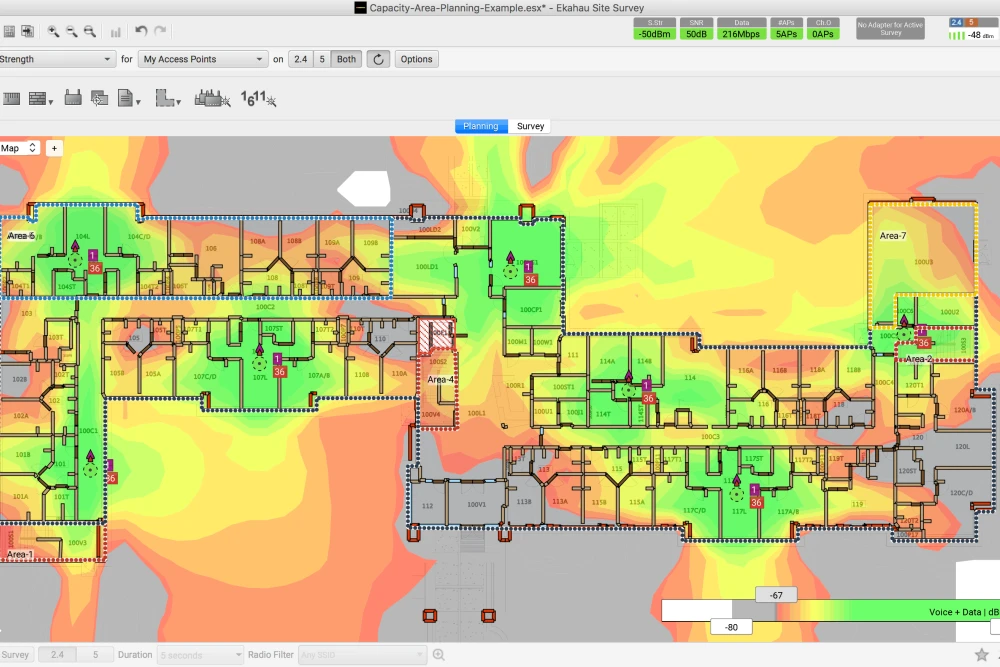Wi-Fi & Network
Wi‑Fi coverage survey: how does it work?

Why run a Wi‑Fi coverage survey?
Internet connectivity is now indispensable for both staff and guests. Ensuring reliable Wi‑Fi in a hotel has been a major priority for years. In 2022, over 90% of guests considered good Wi‑Fi essential and decisive when choosing a hotel. Netflix, calls and video calls, social networks, messaging—so many daily services depend on the internet.
That’s why a professional survey must be carried out to guarantee a powerful, stable signal. By collecting on‑site RF data, the survey highlights gaps and weaknesses so you can fix them. With real‑world measurements, a Wi‑Fi coverage study validates AP placement, the quality of installation (for openings or renovations), and the reliability of your wireless connectivity, so guests can enjoy an efficient, stable connection as they move around.
The key steps
Success requires specialized tools and practical know‑how—including hospitality‑specific challenges. Hotel guests are demanding and unforgiving of networks that are poorly designed or tuned. Use an approach that considers your property’s specifics and the expectations of staff and guests.
The steps below outline a coverage study ahead of a new deployment (more comprehensive), but a standalone performance audit reuses parts of steps 1, 2 & 5:
Step 1: Site review
Assess the site: architecture, materials, wall thickness, floors and ceilings, humidity (spas, indoor pools), outdoor coverage (gardens, rooftops), and potential high‑density zones. Historical buildings may limit cabling options and require alternatives.
Step 2: Predictive modeling
Using floor plans and collected information, specialists build a model with professional tools like Tamograph or Ekahau to determine the number, placement, and types of APs for optimal coverage.
Almost any site can enjoy excellent Wi‑Fi. Some will need more (or more specialized) APs and higher‑end gear.
Step 3: Cabling recommendations
Based on the plan, the expert specifies cable types, routes, exit points, and trunking to connect APs. A certified cabling professional usually executes this work under the direction of the Wi‑Fi engineer. Together—with the client—they may find ways to discreetly integrate APs (drop ceilings, hatches, boxes).
Step 4: Deployment / installation
Execution phase: order and configure the recommended equipment, then install on site—APs, routers, firewalls, Wi‑Fi boxes, and patching on the rack.
Step 5: On‑site connectivity tests
After installation, the engineer tests connectivity with specialized tools and consumer devices (e.g., a smartphone) to verify even coverage, strong throughput, and stable roaming—especially in high‑density areas.
Step 6: Go‑live & acceptance
Once deployed, bring the service online. Options include: open access or a captive portal (codes and/or payment), a branded landing page, advertising partners, session length or throughput limits, etc.
Run your Wi‑Fi coverage study with UTH
Specialized in hotel Wi‑Fi, UTH provides highly qualified network engineers and technicians. With hundreds of studies and deployments across France—and even in parts of Europe for prestigious clients—UTH will deliver a complete, precise, and actionable coverage report with corrective steps if needed. You don’t always need to rebuild everything—sometimes adding a few APs or reconfiguring the setup greatly improves the Wi‑Fi coverage in your hotel and guest satisfaction.
MAG.
Wi-Fi & Network
Cybersecurity & Backup
Video Surveillance & Security
Consulting
IT Managed Services
Wi-Fi & Network

Wi-Fi & Network
How to equip your hotel with fast, reliable Wi‑Fi
Assessing your Wi-Fi connectivity needs Connectivity needs vary from hotel to hotel—that's why a ...
+
+

Wi-Fi & Network
What is Wi‑Fi roaming?
Wi-Fi Roaming: definition Wi-Fi roaming refers to the multiple access points installed within a ...
+
+
Your hotel deserves IT excellence
Let's discuss your challenges, whether you're in the hospitality sector or an SME.